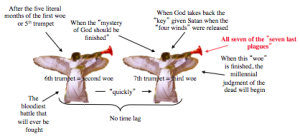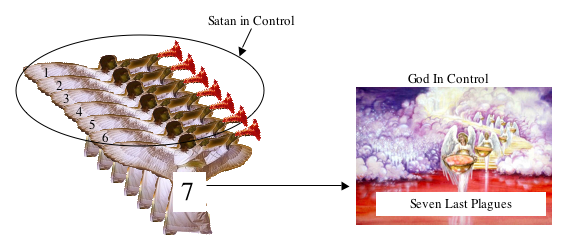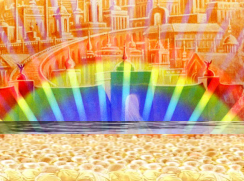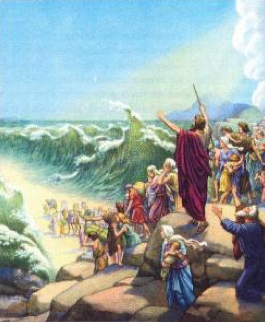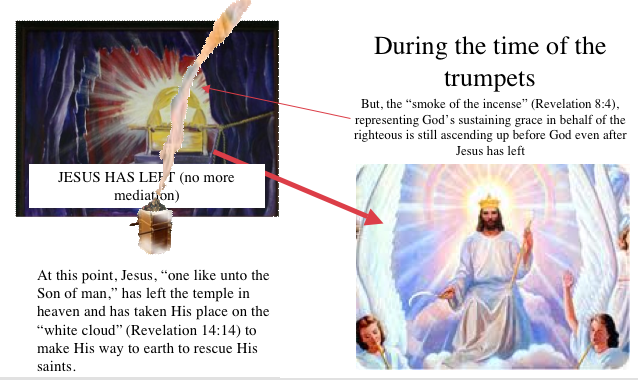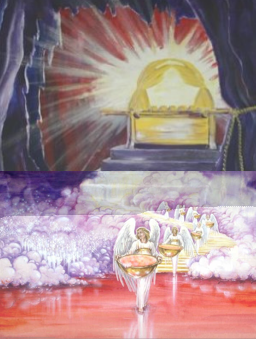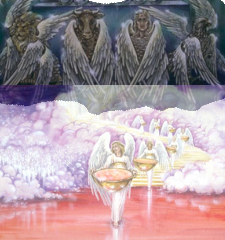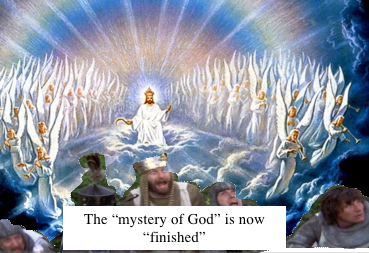If the interpretation of the last Verse of chapter 14 is correct, it left us in the middle of a gruesome lake of blood, measured “by the space of a thousand and six hundred furlongs” and perhaps up to five or six feet deep, resulting from the four angels that were loosed, “which were prepared for an hour, and a day, and a month, and a year, for to slay the third part of men.” [1] That takes place during the sixth trumpet/second woe and will be the bloodiest conflict this world will ever witness during premillennial time (Revelation 9:12-15).
Then “the seventh angel sounded” (third woe) with the announcement that “The kingdoms of this world are become the kingdoms of our Lord, and of his Christ; and he shall reign,” (Revelation 11:15) instead of Satan who was in control during the time of the previous six trumpets, which included the first and second woes. At this time “the mystery of God should be finished” (Revelation 10:7). Then John hears the acclamations of praise and adoration from the 24 Elders who “fell on their faces and worshipped God” because He “hast taken to thee thy great power, and hast reigned” (Revelation 11:16,17), meaning that God was not reigning during the previous trumpet scenarios, but has now taken back the “key of the bottomless pit” that had been relinquished the “to the fallen “star” whose “name in the Hebrew tongue is Abaddon, but in the Greek tongue hath his name Apollyon” (Revelation 9:1, 11). Although this made “the nations angry” (Revelation 11:18), it is really their master, Abaddon, who is angered. The “nations” merely reflect the emotions of their satanic master. Whether the “nations” know it or not, the “third woe” will usher in “the time of the dead, that they should be judged” [2] and God will “give reward unto [His] servants the prophets . . . (Revelation 11:18).
At this point, during the end time scenario of the “third woe,” “the temple of God [will be] opened in heaven, and there [will be] seen in his temple the ark of his testament: and [there will be] lightnings, and voices, and thunderings, and an earthquake, and great hail” (Revelation 11:19). The parallel to the “lightnings, and voices, and thunderings, and an earthquake” and especially, the “great hail” [3] is repeated in more detail in Revelation 16:17-21 where we again find “voices, and thunders, and lightnings . . . a great earthquake . . . and a great hail out of heaven,” which should convince us that the “seventh [trumpet] angel/third woe” is inclusive of all seven of the “seven last plagues” introduced in Revelation 15:1. With that background in mind, we are prepared to explore Chapter 15.
Verse 1: And I saw another sign in heaven, great and marvellous, seven angels having the seven last plagues; for in them is filled up the wrath of God.
The Commentary, on the word “another,” suggests this is a “reference to the sign mentioned in ch. 12:1” [4] where “there appeared a great wonder [5] in heaven; a woman . . .” But here we see “seven angels” instead of a “woman.” Another, more likely parallel, would be the “seven angels” of Revelation 8:2. However, they were given “seven trumpets” instead of the “seven plagues” we see here.
Having reviewed the three woes in our introduction, it should be obvious that the last trumpet is also the third woe (see Revelation 8:13), which is also all seven of the seven last plagues referred to here. Consequently, it would be reasonable to make Verse 1 of this chapter Verse 21 of the previous chapter. Such a simple rearrangement would make clear that the “seven last plagues” follow immediately after the previous six trumpets are sounded. Check out this illustration showing that the seventh trumpet/third woe is inclusive of all the seven last plagues.
Going back to Revelation 8:2, White comments: “To them were given seven trumpets. The Lord was going forth to punish the inhabitants of the earth for their iniquity, and the earth was to disclose her blood and no more cover her slain.” [6] Up to this point, during the previous six trumpets, the earthly inhabitants were being punished indirectly by God because He left them to suffer under the power of Satan (“Wormwood” and “Abaddon/Apollyon” the “destroyer”). As you recall, “Wormwood” was the one with whom the earth dwellers anticipated a thousand years of peace and prosperity after their great victory of the sixth trumpet (see Revelation 9:12-17 and 11:8-13). However, because of the seven plagues that are about to follow, their joy will soon turn to grief and terror (see Revelation 8:13), feeling that God is angry with them and must be appeased.
Now we see “seven angels having the seven last plagues,” instead of trumpets, in which “the wrath of God,” (instead of Satan’s wrath) is “filled up” or “finished.” [7] This is when “the kingdoms of this world are become the kingdoms of our Lord” or when He has taken back His “great power, and hast reigned.” (Revelation 11:15, 17)
Again, up to this point, while the first six trumpets were sounding, inclusive of the first and second woes, the wrath of Satan was being experienced. Now, “the wrath of God” is about to be unleashed by these “seven angels having the seven last plagues” which will finish “the mystery of [who] God” really is (Revelation 10:7).
The Commentary suggests the phrase “seven last plagues” should be “seven plagues, the last.” Such rewording would imply that other “plagues” had preceded these “seven.” [8] Therefore, instead of only “seven” plagues, all of them together add up to a total of thirteen! [9] Remember that the seventh trumpet is a transition point between the trumpets and the plagues, not another trumpet plague in and of itself. Therefore, the total is 13 plagues, not 14.
Verse 2: And I saw as it were a sea of glass mingled with fire: and them that had gotten the victory over the beast, and over his image, and over his mark, and over the number of his name, stand on the sea of glass, having the harps of God.
A short time before, John saw this same “sea of glass” where it was “before the throne” of God the Father, “in the midst” of which were “four beasts full of eyes before and behind” (Revelation 4:6). While there, it looked like “crystal;” here, it appears as though it were “mingled with fire.” That previous scene came to John after Jesus bade him “come up hither, and I will show thee things which must be hereafter.” He then proceeds to describe things he saw in the heavenly sanctuary. We have already concluded that blood and incense in the sanctuary represent mercy, while the horns and fire on the altars represent God’s justice. Therefore, the “sea of glass mingled with fire,” in the context with the seven plagues (Verse 1), suggests that the time of God’s justice has arrived.
But this is a happy scene, in contrast to Verse 1 where “the wrath of God” is depicted. Here, we see the fruits of His mercy having rescued “them that had gotten the victory” over the two satanic beasts (Revelation 13:1,11), who had hoped to wrest them from the worship of the true God. This scene is clearly parallel to the one in which we saw the 144,000 and the “great multitude” standing “on mount Zion” “before the throne of God” (Revelation 14:1-5; 7:15-17).
Strangely, it could be inferred here that God’s people are in heaven, standing on the “sea of glass,” even while the “seven last plagues” are being poured out! Unfortunately, that cannot be the case because those who overcame “the beast, image” and “mark” test had been sealed with the “seal of the living God” (Revelation 7:2) and had come “out of [the] great tribulation,” and experienced “hunger, thirst” and great “heat” during that final “tribulation” (Revelation 7:14, 17), inclusive of the “seven last plagues.” [10] Furthermore, those who “had gotten the victory over the beast . . . image . . . mark, and . . . number” had to have passed the “fifth seal” “test that the people of God must have before they are sealed.” [11] [12] That test came only to those who were living during the final hours of earth’s history when the Investigative Judgment had passed from the dead to the living. They are identified in Revelation 7 as the 144,000 and the “great multitude” who received “the seal of the living God” and who had come “out of [the] [13] great tribulation . . .” “time of Jacob’s trouble (Jeremiah 30:7),” or the seven-trumpet scenario. Therefore, this verse gives special recognition to those who were living when the judgment turned from the dead to the living. [14]
Others, however, who refused to render homage to “the beast, neither his image, neither had received his mark upon their foreheads, or in their hands,” were “beheaded for the witness of Jesus, and for the word of God” (Revelation 20:4). Even though their lives were cut short before the “time of Jacob’s trouble” began, they will certainly be seen standing on the “sea of glass” along with the others who lived through that time and were translated without seeing death (see 1 Thessalonians 4:16, 17). Both groups, those who were martyred and those who proved faithful throughout “the beast . . . image . . . [and] mark” scenario, are judged victorious.
Interestingly, the apostle Paul, after recounting the afflictions of those who were “tortured . . . had trial of cruel mockings and scourgings . . . bonds and imprisonment . . . stoned . . . sawn asunder . . . tempted . . . slain with the sword . . . they without us should not be made perfect” (see Hebrews 11:35-40), suggests that the testimony of the living ratifies the testimony of the dead. Both are needed to complete God’s plan of salvation.
In the final, last day scenario, the ultimate, living witnesses are the 144,000 and the “great multitude” [15] who “came out of [the] great [post probationary] tribulation” (Revelation 7:14). Their living testimony will ratify the testimony of all the martyrs of history, but more specifically, those who were martyred during the final beast, image and mark episode of earth’s history.
Verse 3: And they sing the song of Moses the servant of God, and the song of the Lamb, saying, Great and marvellous are thy works, Lord God Almighty; just and true are thy ways, thou King of saints.
This “song of Moses,” as well as “the song of the Lamb,” must be the same “new song” sung “before the throne” (Revelation 14:3) by the “hundred forty and four thousand” accompanied by “the voice of many waters” (Revelation 14:2, 3; 15:1), which belongs to the “Lamb.” The historic “song of Moses” was sung just after “the children of Israel went into the midst of the [Red] sea upon the dry ground: and the waters were a wall unto them on their right hand, and on their left. And the Egyptians pursued, and went in after them to the midst of the sea, even all Pharaoh’s horses, his chariots, and his horsemen” (Exodus 14:22, 23; 15:1).
The “great multitude,” inclusive of the 144,000 will have gone through a similar experience when the whole world, under the command of Abaddon/Apollyon, the future Egyptian [16] king of the world, will have them cordoned off like caged animals in preparation to annihilate them one and all. At this darkest hour their eyes are “drawn to the East, for a small black cloud . . . about half as large as a man’s hand” has appeared, which they know is “the Sign of the Son of Man,” signifying that their deliverance is coming. [17] “The prophet of Patmos beholds the white-robed multitude that ‘have gotten the victory,’ standing on the ‘sea of glass mingled with fire,’ having ‘harps of God. And they sing the song of Moses the servant of God, and the song of the Lamb.'” [18]
Verse 4: Who shall not fear thee, O Lord, and glorify thy name? for thou only art holy: for all nations shall come and worship before thee; for thy judgments are made manifest.
Paul says: “every knee shall bow to me, and every tongue shall confess to God.” (Romans 14:11) That would include not only the victorious throng standing on the “sea of glass” (Verse 2) who gained the victory over the “beast, image” and “mark,” but also those who did not gain that victory and received the mark of the beast. They will bow just before they “shall be tormented with fire and brimstone in the presence of the Holy angels, and in the presence of the Lamb” (Revelation 14:10). Sadly, they will be like those who “gave glory to the God of heaven” only after they were “affrighted” or terrorized (Revelation11:13). This is much like Moses’ version saying: “The people shall hear, and be afraid . . .” (Exodus 15:14).
Verse 5: And after that I looked, and, behold, the temple of the tabernacle of the testimony in heaven was opened:
This verse is a close parallel to Revelation 11:19 where “the temple of God was [also] opened in heaven” when God took to Himself His “great power” and began to reign after “the seventh angel sounded” his trumpet, which is also “the third woe” that came very “quickly” after the “second” (Revelation 11:14, 15).
As we just learned in Chapter 14, it was during the “second woe” that “the winepress was trodden without the city, and blood came out of the winepress, even unto the horse bridles, by the space of a thousand and six hundred furlongs” (Revelation 14:20). That was Satan’s final destructive act during the premillennial, post probationary scenario of the first six trumpets when he was allowed to demonstrate the unrestrained ruthlessness of his tyrannical government. That scenario began just after Jesus left the “temple” and took His place on the great “white cloud” holding “in his hand a sharp sickle” (Revelation 14:14).
Stating “the tabernacle of the testimony in heaven was opened” suggests it must have been closed during the time of the first six trumpets, while Wormwood and Abaddon/Apollyon were being deified by the wicked. To them, Christ was, as it were, “clothed with a cloud” of impenetrable mystery (Revelation 10:1).
Therefore, the opening of the “temple . . . in heaven” does not mean probation is closed at that time (it was closed prior to the first trumpet, Revelation 8:3-7), but the finishing of the “mystery of God” (Revelation 10:7), when God will reveal Himself, first by means of the “seven last plagues,” and then, literally, at the time of His second coming to earth. That revelation will cause the wicked to cry “to the mountains and rocks, Fall on us, and hide us from the face of him that sitteth on the throne, and from the wrath of the Lamb” (Revelation 6:16).
Verse 6: And the seven angels came out of the temple, having the seven plagues, clothed in pure and white linen, and having their breasts girded with golden girdles.
In Revelation 14:17, only one angel is seen coming “out of the temple which is in heaven.” [19] By now, it seems clear that the “sharp sickle” he was carrying represents God’s passive mode of punishment. During that time, while the first six trumpets are sounding, inclusive of the first and second woes, God permits Satan to carry out his terrible agenda. Throughout that entire period, the “key of the bottomless pit” was held by the fallen “star” (Revelation 9:1, 11).
Now, when “the temple . . . in heaven was opened” a full complement of “seven angels came out of the temple” bearing “seven plagues,” instead of “seven trumpets.” These “plagues” come directly from the hand of God. They represent His active, direct mode of punishment. [20]
Verse 7: And one of the four beasts gave unto the seven angels seven golden vials full of the wrath of God, who liveth for ever and ever.
These are “the four beasts” depicted in Revelation 4 with “the first . . . like a lion . . . the second . . . like a calf . . . the third” with “a face as a man, and the fourth . . . like a flying eagle” (Revelation 4:6, 7). But only “one of” them “gave” out the “seven golden vials full of the wrath of God” to the “seven angels.” Therefore, it is left up to us to decide which one of them handed out the vials. While “the first . . . like a lion” might seem the most likely choice, this indefinite reference suggests that it really doesn’t matter which it was. Note that they all “give glory and honour and thanks to him that sat on the throne” in the temple, [21] therefore, any one of them could be the distributor of the “vials.”
Also note that they all invited us to “Come and see,” when the figures of the “white, red, black” and “pale” horses emerged after the Lamb “opened” the “seven seals” of the record book of heaven (Revelation 6:1, 3, 5, 7).
Since the beasts “like a calf” and “like a flying eagle” introduced the red and pale horses, who were under the control of Satan, now, at the time of the “third woe” (seventh trumpet), that Abaddon/Apollyon has gained full control of the wicked, possibly it is the “fourth” beast, introducer of the “pale horse,” who gives “unto the seven angels seven golden vials full of the wrath of God . . .”
But, more importantly, it appears that one of them may have volunteered to distribute these plagues, because we hear no command coming directly from God. As it seems, all of them are really fed up with Satan’s treacherous behavior. They have just witnessed the sixth trumpet scenario where Satan was instrumental in the slaughter of “the third part of men” (Revelation 9:15, 18). Their “blood” even came up “unto the horse bridles, by the space of thousand and six hundred furlongs” (Revelation 14:20). So, it is unanimous with all four “beasts,” and the twenty-four “elders,” that God should intervene. Consequently, they “fell upon their faces, and worshipped God, saying, We give thee thanks . . . because thou hast taken to thee thy great power, and has reigned” (Revelation 11:16, 17).
Verse 8: And the temple was filled with smoke from the glory of God, and from his power; and no man was able to enter into the temple, till the seven plagues of the seven angels were fulfilled.
As the Commentary suggests, “This undoubtedly means that the time for intercession is past; no one can enter and have access to the mercy seat. The time of preparation is over; now the time has come for the pouring out of the unmingled wrath of God.” [22] As noted previously, the actual passing of “the time for intercession” was when Jesus cast the “censer . . . into the earth,” just before the seven trumpets began to sound (Revelation 8:5). “But in the days of the voice of the seventh angel (or the seven last plagues), the mystery of God should be finished” (Revelation 10:7). The identity of the real God has been a mystery to the wicked, who will have deified two fallen angels, Wormwood and Abaddon/Apollyon. Consequently, it is apparently the “mystery of God” that is finished here, not probation. The wicked finally know God’s true identity―too late!
Note that “no man was able to enter into the temple.” The word “able” is from the Greek “dunamai” closely related to “dunamis” the word used by Paul to describe the power of the Gospel (Romans 1:16). But in this context, “no man” possessed the “power” to “enter into the temple.” Even the righteous (Revelation 14:15) had followed Jesus “out of the temple,” and certainly had no intention of reentering it (in the spiritual sense) until “the seven plagues” were “fulfilled.” The word “able” suggests that some (most likely the disappointed followers of Wormwood) made the attempt. Being unmindful that probation was closed, they “gave glory to the God of heaven” (Revelation 11:13) and wandered “from sea to sea, and from the north even to the east . . . to seek the word of the Lord, and shall not find it” (Amos 8:12), one of the saddest passages of prophecy.
Other depictions of the closing of probation are when the “testimony” of the “two witnesses” was “finished” (Revelation 11:7), when “one like the Son of man” took His place on the great “white cloud” (Revelation 14:14), and also when “Michael” shall “stand up” (Daniel 12:1). Now, after “the temple . . . in heaven was opened” (Verse 5), we see it here “filled with smoke from the glory of God” the Father, after “one like unto the Son of man” (Revelation 14:14) had departed from His presence, left the heavenly sanctuary and stepped onto the great “white cloud” that will carry Him to the earth at the time of His second coming.
Summary of Chapter 15: Chapter 15 follows in logical sequence of the sixth trumpet scenario, last referred to in Revelation 14:20, where the sickle wielding action of the destroying angel (Verse 18) caused “blood” to come “out of the winepress” “of the wrath of God,” “even unto the horse bridles,” which must be the time when “the third part of men” were killed during the sixth trumpet/second woe scenario (Revelation 9:13-21). This chapter’s introduction to the “seven last plagues,” is interrupted briefly with the happy scene (Verses 2 & 3) of the victors who had been obliged to witness the post probationary trumpet events and have received their heavenly reward. Then, from Verses 5-8, the scene returns back to the introduction to the plague scenario, first referred to in Verse 1. The smoke-filled temple (Verse 8) represents the post probationary situation existing in the heavenly sanctuary that was on-going throughout the trumpet events, beginning after Jesus “cast the censer into the earth” (Revelation 8:5). After that, He left the heavenly temple to take His place on the “white cloud” (Revelation 14:14). Consequently, the “seven last plagues” succeed the first six trumpets, which could also be understood as “plagues,” when Satan is given complete control of the wicked. Judging from Revelation 11:14, 15 and 19, the “seven last plagues,” referred to as such in this chapter, are “the third woe/seventh trumpet” scenario, which comes “quickly” after “the second woe/sixth trumpet is past.” The next chapter itemizes the terrible events to take place during the “third woe” time after “the seventh angel sounded” (Revelation 11:15) his trumpet. While the previous six trumpets represent God’s passive/indirect mode of punishment, the last trumpet, with its seven “vials full of the wrath of God” (Verse 7), represents God’s active/direct mode of punishment, also described in Isaiah 28:21 as His “strange work” or “strange act.”
[1] “even unto the horse bridles” (Revelation 14:20), that is if those strange horses are the same size as ordinary horses!
[2] This “time of the dead” is not the same “time of the dead” that began in 1844. It refers to the judgment of the wicked dead during the millennium that I call the “assessory” judgment. It is depicted in Revelation 20:4 where John “saw thrones, and they sat upon them, and judgment was given unto them . . .” ―we might say they were assessing the fairness of God in His judgment of the wicked.
[3] E.G. White uses this text in The Great Controversy, page 433, in context with 1844 when Christ left the holy place in the heavenly sanctuary and went into the Most Holy place. But notice carefully, she only quoted the first part of the text: “’The temple of God was opened in Heaven, and there was seen in his temple the ark of his testament.’ [Rev.11:19.]” She quotes the entire verse in Battle Creek Letters, page 57, when “The Kingdoms of this world are soon to become the kingdoms of our Lord.” The same thought is found in Manuscript Releases, Vol. 20, page 221, where “Not long hence they will receive their reward. Writing of the last days, John says: [Rev.11:18 quoted].” See also Manuscript Releases, Vol. 18, page 187 and Vol. 14, page 161.
[4] Seventh-day Adventist Bible Commentary, Vol. 7, page 836 (top left column)
[5] The words “sign” and “wonder” are translated from the same Greek word “semeion” (Strong’s #4592)
[6] Here is the entire quote from Manuscript Releases by E.G. White, Vol. 15 page 219: “Thy right hand, O God, shall dash in pieces Thine enemies. Revelation 6 and 7 are full of meaning. Terrible are the judgments of God revealed. The seven angels stood before God to receive their commission. To them were given seven trumpets. The Lord was going forth to punish the inhabitants of the earth for their iniquity, and the earth was to disclose her blood and no more cover her slain. Give the description in chapter 6.” Note the underlined portion that quotes Revelation 8:2 even though no reference is given. If you look it up, the preceding paragraph refers to Revelation 16:1 and in the following paragraph, on page 220, she alludes to the “plagues” and the “hail.” Therefore, the least we can conclude is that the context of that quote, as well as the entire paragraph itself, is future.
[7] The two words “filled up” are from “teleo” (Strongs’ #5055) meaning “finished, fulfil, accomplish” etc. It is the same word translated “finished” in Revelation 10:7 and 11:7 where “the mystery of God should be finished” and the testimony of the two witnesses is “finished.”
[8] Seventh-day Adventist Bible Commentary, Vol. 7, page 836 (top left column under “seven last plagues.)
[9] Six satanic “plagues” succeeded by seven last plagues from the Lord comes to a total of “13” plagues. An interesting parallel exists in Joshua 6 where Jericho was surrounded once a day for “six days” (Verse 3). Then on the “seventh day” they surrounded the city “seven times” (Verse 4). After blowing the trumpets the wall of the city fell down. So, the six surroundings of the preceding six days plus the seven surroundings on the seventh, come to a total of thirteen surroundings, the same number of trumpet events we have identified in the book of Revelation.
[10] see Last Day Events by E.G. White, page 268, 269; Early Writings by E.G. White, page 19; Spiritual Gifts by E.G. White, Vol. 2, page 54, etc.
[11] the “fifth seal” of Revelation 6:9-11. See also Revelation 20:4.
[12] 1888 Materials by E.G. White, page 701; Manuscript Releases by E.G. White Vol 15, page 15; Seventh-day Adventist Bible Commentary, Vol. 7, page 976
[13] Almost all other translations of the Bible use the definite article “the” preceding “great tribulation.”
[14] “The eye of God, looking down the ages, was fixed upon the crisis which His people are to meet, when earthly powers shall be arrayed against them. Like the captive exile, they will be in fear of death by starvation or by violence. But the Holy One who divided the Red Sea before Israel, will manifest His mighty power and turn their captivity. ‘They shall be Mine, saith the Lord of hosts, in that day when I make up My jewels; and I will spare them, as a man spareth his own son that serveth him.’ [Mal. 3:17] If the blood of Christ’s faithful witnesses were shed at this time, it would not, like the blood of the martyrs, be as seed sown to yield a harvest for God. Their fidelity would not be a testimony to convince others of the truth; for the obdurate heart has beaten back the waves of mercy until they return no more. If the righteous were now left to fall a prey to their enemies it would be a triumph for the prince of darkness. Says the psalmist, ‘In the time of trouble He shall hide me in His pavilion; in the secret of His tabernacle shall He hide me.’ [Ps. 27:5] Christ has spoken: ‘Come, My people, enter thou into thy chambers, and shut thy doors about thee: hide thyself as it were for a little moment, until the indignation be overpast. For, behold, the Lord cometh out of His place to punish the inhabitants of the earth for their iniquity.’ [Isa. 26:20, 21] Glorious will be the deliverance of those who have patiently waited for his coming, and whose names are written in the book of life.” (The Great Controversy by E.G. White, page 634; underlining supplied)
[15] Some are troubled by the concept that the “great multitude” (Revelation 7:9) go through the same time of Jacob’s trouble as the 144,000. Consider this passage: “But while anguish was upon the loyal and true, who would not worship the beast or his image and accept and revere an idol sabbath, One said, ‘Look up! Look up!’ Every eye was lifted, and the heavens seemed to part as a scroll when it is rolled together, and, as Stephen looked into the heaven, we looked. The mockers were taunting and reviling us and boasting of what they intended to do to us if we continued obstinate in holding fast our faith. But now we were as those who heard them not. We were gazing upon a scene that shut out everything else.
“There stood revealed the throne of God. Around it were ten thousand times ten thousand and thousands upon thousands, and close about the throne were the martyrs. Among this number I saw the very ones who were so recently in such abject misery, whom the world knew not, whom the world hated and despised.
“A voice said, ‘Jesus, who is seated upon the throne, has so loved man that He gave His life a sacrifice to redeem him from the power of Satan, and to exalt him to His throne. He who is above all powers, He who has the greatest influence in heaven and in earth, He to whom every soul is indebted for every favor he has received, was meek and lowly in disposition, holy, harmless, and undefiled in life.
“‘He was obedient to all His Father’s commandments. Wickedness has filled the earth. It is defiled under the inhabitants thereof. The high places of the powers of earth have been polluted with corruption and base idolatries, but the time has come when righteousness shall receive the palm of victory and triumph. Those who were accounted by the world as weak and unworthy, those who were defenseless against the cruelty of men, shall be crowned conquerors and more than conquerors.’ [Rev. 7:9-17, quoted.]” (Manuscript Releases by E.G. White, Vol. 21, pate 326, underlining supplied) Read the following paragraphs where “They have come out of great tribulation” and Revelation 7:10 is again quoted, to assure yourself that the “great multitude” does, indeed, share that experience with the 144,000.
[16] “Egyptian,” because the religious philosophy of the world at that time will be overt devil worship. Therefore, it will be nearly identical to the “atheism” of Pharoah as well as the “licentiousness” of Sodom. (see The Great Controversy by E.G. White, page 269) That should make us think of “the great city, which spiritually is called Sodom and Egypt . . .” (Revelation 11:8)
[17] Word to the Little Flock by E.G. White, page 15
[18] see Patriarchs and Prophets by E.G. White, page 289, where Revelation 15:2,3 are quoted.
[19] Remember in chapter 14, the “angel” (Verse 15) represents the saints on earth and the other “angel who “came out from the altar” (Verse 18), represents Jesus, the “Son of man” (Verse 14), who, we can assume, just left the “temple” in heaven, but is not called an “angel.”
[20] Early Writings by E.G. White, page 521.
[21] see Revelation 4:9. Although I added the word “temple,” go back and restudy verse 1 where “a door was opened in heaven” which must be the entrance into the heavenly sanctuary.
[22] Seventh-day Adventist Bible Commentary, Vol. 7, page 837 (right column under “No man.”)
